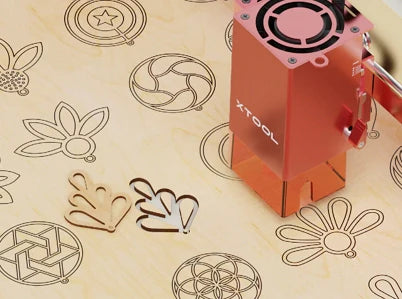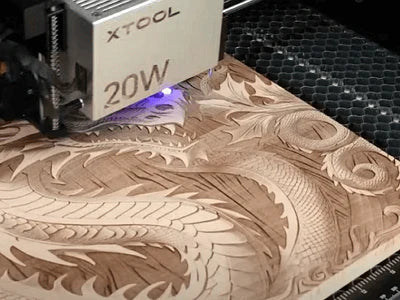Learning how to use heat transfer vinyl is a rewarding experience. Heat transfer vinyl, or iron on vinyl, is a versatile material that can be cut into any shape or design and then applied to fabric and other materials that can take the heat using heat and pressure, enabling you to make your own custom t-shirts, shoes, tote bags, pillows, mugs, and more or even start a small business. To unlock these opportunities, a vinyl cutting machine is an ideal option. If you're new to using this material, our step-by-step guide on how to use heat transfer vinyl with a vinyl cutting machine will get you started quickly.

In This Article
- Why Using Heat Transfer Vinyl?
- Choosing the Right Vinyl Cutting Machine
- Materials Needed for Heat Transfer Vinyl Projects
- How to Use Heat Transfer Vinyl with xTool M1
- Conclusion
Why Use Heat Transfer Vinyl?
You may be wondering about the advantages of using heat transfer vinyl (HTV) instead of other fabric customization methods and materials like screen printing, embroidery, or adhesive vinyl. Well. There are several benefits to using heat transfer vinyl that make it an excellent choice for both hobbyists and professionals.
Unlimited design possibilities: Heat transfer vinyl allows you to bring any design you can imagine to life. Whether it's simple text and shapes or intricate graphics. Heat transfer vinyl offers a wide range of colors, finishes, and textures like glitter, metallic, holographic, flock, and more. You can even combine different types of heat transfer vinyl to create unique effects and layers.
Durability: Heat transfer vinyl is specifically designed to withstand washing and wearing without fading, cracking, or peeling over time. Unlike adhesive vinyl that can easily come off if not properly applied or exposed to heat or moisture. Heat transfer vinyl permanently bonds with fabric fibers through heat and pressure. This ensures your designs will maintain their quality for a more extended period.
Cost effectiveness: Compared to other fabric customization methods. Heat transfer vinyl is relatively affordable. Getting started only requires minimal materials and equipment such as a vinyl cutting machine, a heat press or iron. And some heat transfer vinyl sheets or rolls. Additionally purchasing in bulk or utilizing scraps for smaller projects can help save money.
Ease of Use: When equipped with the appropriate tools, especially a reliable vinyl cutting machine, using heat transfer vinyl becomes effortless. This user-friendly material caters to both novices venturing into the world of DIY projects and seasoned professionals seeking to create consistent and top-notch designs.
 Shop heat transfer vinyl
Shop heat transfer vinylChoosing the Right Vinyl Cutting Machine
Now that you know why you should use heat transfer vinyl, you might be wondering how to choose the right vinyl cutting machine for your needs. But first, let’s understand how a vinyl cutting machine works and what it can do.
How a vinyl cutting machine works
A vinyl cutting machine is a device that can cut various materials, such as vinyl, paper, cardstock, and fabric, into precise shapes and designs. It's controlled by computer software to cut the design. You can create your design in it or upload the design created in other design software, and then send it to the machine. The machine will then use a small blade to cut out your design from the material you have chosen based on your design file.
What a vinyl cutting machine can do
A vinyl cutting machine can help you create amazing projects with heat transfer vinyl and other materials. You can use it to make custom t-shirts, tote bags, pillows, signs, stickers, decals, labels, and more. You can also use it to cut other materials, such as paper, cardstock, fabric, leather, felt, and more. You can create anything from greeting cards and invitations to leather bags.

There are many factors to consider when buying a vinyl cutting machine, such as the size, speed, accuracy, compatibility, and price of the machine. However, there is one machine that stands out from the rest and offers everything you need for your heat transfer vinyl projects: the xTool M1.
Why xTool M1 is the best choice
The xTool M1 is a desktop laser and blade cutting machine that features laser cutting, laser engraving, and blade cutting in one device. This means you can work with a wide range of materials, from thick wood to thin paper, and create amazing designs with ease. Its blade cutting feature is specifically designed to handle vinyl materials, making it an invaluable tool for vinyl-based projects.

One of the standout aspects of the xTool M1 is its user-friendly approach. The device is pre-assembled and ready to use right out of the box, sparing you the trouble of complicated setups. And the 16MP smart camera offers a real-time preview of the workspace. This ensures hassle-free positioning of your designs on the material. This device eliminates the need for time-consuming manual adjustments. With its autofocus functionality, the blade can be effortlessly set to cut the heat transfer vinyl with just a click.
Additionally, the xTool M1 boasts beginner-friendly software. Not a designer? Don't worry. The software offers access to hundreds of pre-existing designs, granting you the freedom to choose and experiment.
In conclusion, the xTool M1's top-notch cutting capabilities, ease of use, and intuitive software make it a worthwhile investment for both novice and experienced vinyl enthusiasts. Its integration of laser and blade cutting technologies, coupled with a range of user-friendly features, sets it apart from the competition, making it the vinyl cutting machine of choice for your creative endeavours.
Materials Needed for Heat Transfer Vinyl Projects
Before you start using heat transfer vinyl with your vinyl cutting machine, you need to make sure you have all the necessary materials and tools. Here is a list of what you will need.
Heat transfer vinyl: This is the main material you will use to create your designs. There are different types of heat transfer vinyl, such as smooth, flocked, glitter, metallic, holographic, and more. You can choose the type that suits your project best.
 Shop heat transfer vinyl
Shop heat transfer vinylVinyl cutting machine: This is the device that will cut your heat transfer vinyl or iron-on vinyl into your desired design. You can use any vinyl cutting machine that works with heat transfer vinyl, such as the xTool M1. You will also need a software program to create or upload your design and send it to the machine. You can use the software that comes with your machine or any other compatible software.

Cutting Mat: A cutting mat protects your work surface when cutting the design and helps increase the life of the blades.
Weeding tool: This is the tool that will help you remove the excess heat transfer vinyl material from your design after cutting it with your vinyl cutter. You will need to carefully peel off the unwanted parts from the carrier sheet (the clear sheet that protects your HTV) and leave only your design on it.

Iron or heat press machine: This is the device that will apply heat and pressure to your heat transfer vinyl design and transfer it to your fabric. You can use a regular home iron or a heat press machine. A heat press machine is recommended for professional or bulk projects, as it can ensure better durability and quality of your HTV designs. However, a home iron can also work well for smaller or hobby projects, as long as you use enough heat and pressure.
Cover sheet: This is the sheet that will protect your heat transfer vinyl design from direct contact with the iron or heat press. You can use any thin and heat-resistant sheet, such as parchment paper or a thin cloth. You will need to place the cover sheet over your heat transfer vinyl design before applying heat and pressure to it.
Something to transfer your HTV design onto: This can be anything made of fabric that you want to customize with your HTV design, such as a t-shirt, a tote bag, a pillowcase, etc.
These are the basic materials and tools you will need for your heat transfer vinyl projects. However, depending on your project and preferences, you may also need some additional items, such as:
Scissors: You may need scissors to cut your heat transfer material into smaller pieces or shapes before cutting it with your vinyl cutting machine. This can help you save material and avoid waste.
Ruler or measuring tape: You may need a ruler or measuring tape to measure your fabric and heat transfer vinyl material and ensure they are aligned properly. This can help you avoid mistakes and achieve better results.
Pen or marker: You may need a pen or marker to mark your fabric where you want to place your design. This can help you position your design correctly and avoid crookedness.
What Laser Cutter Do You Need to Cut Cardboard?
Here we will show you how to use the heat transfer vinyl with the xTool M1 vinyl cutting machine to customize a canvas bag. You can follow the same steps for other projects and materials as well.
Step 1: Prepare your design
The first step in using heat transfer vinyl is to create or upload your design file in the software program that controls your vinyl cutting machine. For the xTool M1, you can use the xTool Creative Space (XSC) software, which is free and easy to use.
For this project, we will use a butterfly design. xTool M1 supports the import of images in common vector and bitmap formats, including SVG, DXF, PNG, JPG, and BMP. You can use any of these formats to create or upload your design. However, for vinyl cutting (blade cutting), the design format should be vector(SVG).
If you don't know how to create a design, you can purchase it online and there are also many sites providing free SVG graphics, such as designbudles.net.
Step 2: Cut your design
The next step is to cut your design with your vinyl cutting machine. For the xTool M1, you will need to connect your machine to your computer or mobile device via wifi or USB. You will also need to assemble the blade head and insert it into the machine.
Before you cut your design, you need to prepare your heat transfer material. You need to place your heat transfer vinyl material on a cutting mat with the shiny side facing down. The shiny side is the carrier sheet that protects your HTV material and helps you transfer it to your fabric later. You also need to make sure that your HTV material is smooth and flat on the cutting mat without any wrinkles or bubbles.

Then, you need to load your design file into the software, and scale it as needed. Then select the "blade cut" mode and choose the "heat transfer vinyl" from the material selection. The machine will automatically detect the type and thickness of your HTV material and adjust the settings accordingly.

Next, you need to make sure that you mirror your design horizontally in the software. This is because you are cutting your design on the back side of your HTV material and you want it to appear correctly on your fabric.


After that, perform the framing to make sure of the design's positioning. Then click the button to start the cutting process. Now, you only need to wait for the process to complete.
Step 3: Weed your design
After the cutting is done, you can start by peeling off a corner of the HTV material from the carrier sheet and then pulling it gently. You can also use your weeding tool to lift up any small pieces or details that are hard to peel off by hand. Be careful not to damage or remove any parts of your design that you want to keep. When you have weeded out all the excess HTV material from your design, you should have only your design left on the carrier sheet.


Step 4: Transfer your design
The fourth step is to transfer your design to your fabric with heat and pressure. For this project, we will use the heat transfer vinyl on a canvas bag. You can use any fabric that can withstand high heat, such as cotton, polyester, nylon, rayon, etc.
Before you transfer your design, you need to preheat your iron or heat press machine according to the instructions for your specific fabric and heat transfer type. You also need to preheat your fabric for a few seconds to remove any wrinkles or moisture. Then you can place a cover sheet over your fabric to protect it from direct contact with the iron or heat press.

Next, you need to position your heat transfer vinyl design on top of your fabric where you want it to be transferred. Make sure that the carrier sheet is facing up and that your design is aligned correctly with your fabric.
Then, you need to apply heat and pressure to your heat transfer vinyl design with your iron or heat press for a certain amount of time according to the instructions for your specific fabric and heat transfer type.

When the time is up, you need to remove the iron or heat press from your heat transfer vinyl and let it cool down for a few seconds. Then, you need to peel off the carrier sheet carefully. Some types of HTV require a hot peel, which means peeling off the carrier sheet while it is still warm. Other types of HTV require a cold peel, which means waiting until the carrier sheet is completely cool before peeling it off.
If you have followed all these steps correctly, you should have successfully transferred your heat transfer vinyl design onto your fabric. Congratulations! You have just customized a canvas bag with your vinyl cutting machine and heat transfer vinyl.
Conclusion
Diving into the world of heat transfer vinyl with a vinyl cutting machine is a journey of creativity and opportunity. This guide aimed to equip you with the necessary knowledge, from understanding the benefits of heat transfer vinyl, and gathering the required materials, to sparking your imagination with vinyl project ideas.Our vinyl cutting machine is designed to be your reliable partner in this journey, making each project more efficient and enjoyable. We hope you found this guide informative and inspiring.
Related Articles

How to Make A Stencil?

Laser Cut Art: Top 10 Projects to Elevate Interiors


